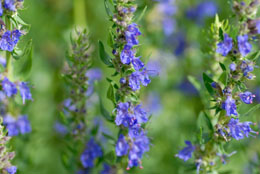Hyssop is a herb that has been well-known for its medicinal and culinary uses. Know more about its benefits in this article.

Hyssop is a perennial herb that belongs to the family of mint plants, called
Lamiaceae and is native to the Mediterranean region. The plant is known for possessing slender and stiff stems which grow up to a height of 2 to 3 feet. It bears opposite leaves on the stem which are 1 and 1/2 inches long, hairless, narrow and pointed in shape. Hyssop plant grows blue to purple blue colored, bell shaped tubular flowers that bloom from the month of July in the summer through October in the fall season. These flowers are endured as small one sided clusters, set along the upper portion on the stems of the plant.
Hyssop plant grows well in a well drained soil and prefers full sun or partial shade. Like other members of the mint family, hyssop also has a highly aromatic camphor like smell due to the presence of strong aromatic and volatile oils found in its leaves, stems and flowers.
Hyssop Uses and Benefits
Medicinal Uses
Hyssop herb has been used as an effective herbal medicine for centuries. Today the best known species of hyssop herb, commonly used for its healing virtues is
Hyssopus officinalis. The herb produces a special volatile oil which is stimulative, carminative and sudorific, hence, offers numerous health benefits. Research shows that hyssop contains compounds like pinocamphone, isopinocamphone, camphene, alpha and beta pinene, and alpha terpinene which altogether accounts for about 70% of the aromatic oil in the plant.
The plant is used as a herbal remedy for various respiratory disorders, including common cold, chronic coughs, hoarseness in the voice, fever, sore throats, etc. Especially, the herbal hyssop tea when combined with some honey acts as a strong expectorant agent that helps loosen the accumulated phlegm and makes its expulsion easier. Hence, it helps patients dealing with nasal congestion by stimulating an expectorant action in the body which leads to the instant clearing of thick and congested phlegm or mucus accumulated in the blocked respiratory passages.
To know how to prepare hyssop herbal tea, just infuse a tablespoon of dried hyssop leaves or flowers in boiling water, let the herb steep in the water and then strain it. After this, add honey to sweeten it and to add some taste. For more flavor, you can also mix hyssop herb with some spearmint or lemon balm. Apart from these, the herb is also known to cure wounds or cuts on the skin, skin irritations, burns, frostbite, etc. and has the ability to heal injuries caused from rusty farm implements or weapons. This healing ability is basically due to the growth of the penicillin producing mold on leaves of the hyssop plant. The herb is also useful in treating asthma, urinary tract inflammation, appetite stimulation, stomach bloating, gas and colic (acute abdominal pain).
Culinary and Other Uses
In earlier times, the Romans and Greek, used hyssop as a cooking herb. However, even today hyssop leaves and flowers that contain a light bitter mint flavor, are used as a seasoning in all kinds of vegetable dishes, soups, all sorts of casseroles and sauces, as well as pickles and preserve. Hyssop leaves are used as stuffing for meats and poultry as well as in many salads for its refreshing flavor and taste. It is also used in many cosmetic and perfumery industries to add fragrance to perfumes, soaps and cosmetics. Moreover, dried hyssop flowers are used in flower arrangement and other decorative purposes.
Now that you know what is hyssop used for and how it benefits us, I am sure you will not forget to incorporate this essential herb in your lifestyle. Though hyssop has numerous health benefits, hyssop contains the chemical component pinocamphone, which is slightly toxic in nature, hence people suffering from high blood pressure, epilepsy and even pregnant women, should avoid consumption of this herb.






 Hyssop is a perennial herb that belongs to the family of mint plants, called Lamiaceae and is native to the Mediterranean region. The plant is known for possessing slender and stiff stems which grow up to a height of 2 to 3 feet. It bears opposite leaves on the stem which are 1 and 1/2 inches long, hairless, narrow and pointed in shape. Hyssop plant grows blue to purple blue colored, bell shaped tubular flowers that bloom from the month of July in the summer through October in the fall season. These flowers are endured as small one sided clusters, set along the upper portion on the stems of the plant.
Hyssop is a perennial herb that belongs to the family of mint plants, called Lamiaceae and is native to the Mediterranean region. The plant is known for possessing slender and stiff stems which grow up to a height of 2 to 3 feet. It bears opposite leaves on the stem which are 1 and 1/2 inches long, hairless, narrow and pointed in shape. Hyssop plant grows blue to purple blue colored, bell shaped tubular flowers that bloom from the month of July in the summer through October in the fall season. These flowers are endured as small one sided clusters, set along the upper portion on the stems of the plant.